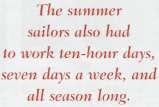 |
Home | Search | Browse | About IPO | Staff | Links |
 |
Home | Search | Browse | About IPO | Staff | Links |
|
Serving on the Great Lakes Coeds made money and memories on the Georgian Bay Line By William Furry
It was the summer of 1942 and the world was at war. But for Helen Lee Hensleigh Wenger and nearly two-dozen other Midwestern college coeds, it was the beginning of a grand adventure on the Great Lakes, an experience that built character and lasting friendships, and earned them much-needed cash for school. The "Fresh Water College Girls," as the coeds were nicknamed by the Chicago Tribune, were recruited as waitresses and entertainers aboard the S.S. North American, an excursion vessel that traveled from Navy Pier in Chicago to Buffalo, New York, via Mackinac Island and Detroit. It was a large ship, part of the Chicago-based Georgian Bay Line, carrying some 300 passengers and crewmembers. The cruise line ran three ships in the Great Lakes—the S.S. Alabama, the S.S. South American, and S.S. North American; all catered to affluent Americans and their allies, who, advised against traveling in Europe, sought pampered vacations in luxurious stateside settings. Earlier this year, Wenger, now 82 and a resident of Iowa City, Iowa, shared her experiences aboard the American in a letter to the Illinois State Historical Society, which also included a packet with several photographs and newspaper articles. "I hope these [photos] may add to your files on those war years," she wrote. 
Not all coeds were cut out for a life "at sea," even as a summer job. According to the Tribune article, the Fresh Water coeds had to meet stiff requirements: "She has a good school record; a good reputation and personality; she is amenable to the discipline on board ship (which approximates that of a sorority house—no drinking, no shirking, no social entanglements with strangers, in this case passengers); she is talented enough to work into the song and dance entertainment the college girls provide for passengers; and she is a good sailor." The summer sailors also had to work ten-hour days, seven days a week, and all season long. Despite the long hours, close quarters, and personal inconveniences, the coeds found time to play and soak up the sun on the deck. And they had "noons off" on weekends in Chicago and Buffalo, which they reserved for shopping and dining out. It was their only respite from their hectic shipboard life. "We lived crammed in tiny cabins in the 'harem'," Wenger wrote, "where all waitresses and maids lived (in the bumpiest part of the ship) eight to a room. We worked very long hours, ENJOYED it, and were grateful to have the job which paid more (from our tips) than any other summer job we could have had." But serving food on a listing ship was no picnic. "When it was rough a waitress just had to go on and serve," Wenger wrote. "I was always easily seasick, and would run upstairs to the 'harem' bathroom, "upchuck," and come right down to serve trout swimming in butter and blueberry pie—gushingly a la mode!" In addition to waiting tables, the coeds and crewmembers earned extra money staging short plays and skits for the passengers. In one skit Wenger played "the bride" in a dance number called "The Jitter Bug Wedding." Playacting aside, the young women were chaperoned strictly onboard ship and not allowed to fraternize with passengers or male crewmembers. The only socializing that took place was in the workspaces, Wenger wrote, but there were even proscriptions there. "The sad thing is that we couldn't socialize with the black busboys—with whom we worked very closely all those ten hours a day," she wrote. In port, the coeds had more freedom to socialize with crewmembers, but "we never dared to meet with the personable and respected black college students," observed Wenger. 18 Illinois Heritage For two summers Wenger worked for the Georgian Bay Line, but the friendships she made endured more than 60 years. She noted that "Ford," one of the African-American waiters she worked with, was still working for the line in the early 1970s, and recognized one of the coeds years later when she visited the S.S. American at Navy Pier. The ship was later docked in Holland, Michigan, where it spent most of the offseason months. There, in the early 1980s, it "sank quietly" into the bay. "There went a piece of our unique and unusual experience," Wenger wrote.  In 1943, coeds and crew who served and entertained on board the S.S. North American held a farewell banquet. The students attended several schools, including: University of Illinois, MacMurray College, Valparaiso University, Heidelburg College, Sweet Brian, and Bradley Tech. Photo courtesy Helen Lee Hensleigh Wengler. 19 Illinois Heritage |
|
|